teodor
National Hazard
   
Posts: 876
Registered: 28-6-2019
Location: Heerenveen
Member Is Offline
|
|
Menthyl acetate
I'd like to make this ester of menthol. Could you supply me with the procedure?
It looks like Fischer esterification with just acetic acid is not mentioned as a standard method of preparation.
I found the article: https://doi.org/10.1063/5.0059481 . It is a new article (not on sci-hub yet) and the method with acetyl chloride looks like an interesting one
(because I have it). So, I wish to get this article to start experiments with some already proven procedure. I can buy it but probably somebody can
have free access through university. If so, could you please share the article?
[Edited on 31-12-2021 by teodor]
|
|
|
Texium
Administrator
       
Posts: 4566
Registered: 11-1-2014
Location: Salt Lake City
Member Is Offline
Mood: PhD candidate!
|
|
If you have acetyl chloride, preparing the ester should be trivial by simply combining your menthol with an excess of an organic base like
triethylamine or pyridine (if you don't have any, potassium carbonate or potassium hydroxide might work ok instead) in an unreactive solvent like
ether or THF, and then adding in the acetyl chloride, also in excess.
Edit: Also, I tried accessing the article through my university, but unfortunately it appears it doesn't subscribe to that particular journal.
[Edited on 12-31-2021 by Texium]
|
|
|
mayko
International Hazard
    
Posts: 1218
Registered: 17-1-2013
Location: Carrboro, NC
Member Is Offline
Mood: anomalous (Euclid class)
|
|
Sutrisno, Wijaya, H. W., Retnosari, R., & Putri, D. E. E. (2021). Effectiveness of menthyl acetate synthesis with different acetyl groups
equivalent. AIP Conference Proceedings, 2360(September), 050047. https://doi.org/10.1063/5.0059481
Attachment: Effectiveness of menthyl acetate synthesis with different acetyl groups equivalent.pdf (934kB)
This file has been downloaded 258 times
al-khemie is not a terrorist organization
"Chemicals, chemicals... I need chemicals!" - George Hayduke
"Wubbalubba dub-dub!" - Rick Sanchez
|
|
|
teodor
National Hazard
   
Posts: 876
Registered: 28-6-2019
Location: Heerenveen
Member Is Offline
|
|
Thanks, mayko.
I will try both methods. Just mixing menthol and acetyl chloride (and allowing HCl to go) looks simpler, but your method, Texium, is a more general
one, probably I should master it and try with different acid chlorides. And yes, I have pyridine.
|
|
|
Texium
Administrator
       
Posts: 4566
Registered: 11-1-2014
Location: Salt Lake City
Member Is Offline
Mood: PhD candidate!
|
|
Mixing the two reagents like they did in that paper seems a little weird to me. Acetyl chloride is effectively acting as the solvent. Menthyl acetate
may be a liquid, which could help keep the starting materials in solution and in contact with each other, but it likely still won't be as efficient as
running it in a solvent... the fact that they report a 65% yield goes to show that it's likely not as good as the more typical method I suggested.
There's no reason it shouldn't be a 90+% yielding reaction. That being said, I'm eager to see the results of both methods!
[Edited on 12-31-2021 by Texium]
|
|
|
MichaelBijanAfghani
Harmless

Posts: 19
Registered: 15-11-2021
Member Is Offline
|
|
I have a youtube video on making esters from alcohols and acid chlorides. https://www.youtube.com/watch?v=3wA__rOdcF8
Just replace tert-amyl alcohol with equivalent moles of menthol.
Fischer esterification is worth a try. Secondary alcohols can react in fischer esterification but they require really long reflux times, at least 10
hours.
- Michael Afghani
[Edited on 1-1-2022 by MichaelBijanAfghani]
|
|
|
teodor
National Hazard
   
Posts: 876
Registered: 28-6-2019
Location: Heerenveen
Member Is Offline
|
|
So, this is my way of synthesis.
29.2g of L-Menthol (the nice bottle which I've got as a present from Fery).
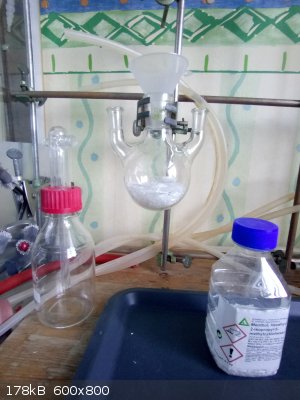
30ml of acetyl chloride.
I expected HCl evolution so I assembled a reflux setup and a dropping funnel.
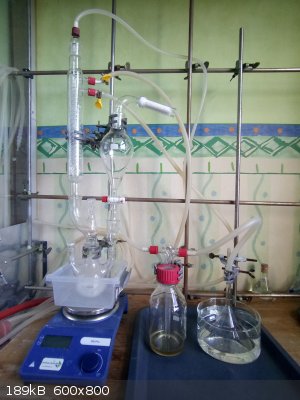
It was not necessary. You can mix the ingredients the normal way, you have enough time for that - the reaction doesn't start immediately. Menthol is
dissolving in AcCl and after some time the bubbling starts in the form of foam over the liquid. I use a cold water bath to keep the temperature low,
as was suggested in the paper.
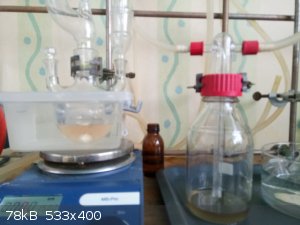
The amount of HCl which excels at this step is much less than stoichiometry - probably it becomes dissolved in the mixture or the reaction is not
completed - HCl didn't reach the inverted funnel and I doubt it even reached the gas washing bottle.
After 80 mins of stirring the foam almost disappears. Bubbling is not completed but the rate after 80 mins is very slow.
To complete the reaction I've attached the reaction flask to the water aspirator through a wash bottle with NaOH. The vacuum pulls the rest of HCl and
then probably some unreacted AcCl. In the wash bottle (both inlet and outlet are above NaOH solution) it is possible to see how the gas is mixing with
NaOH and when it stops.
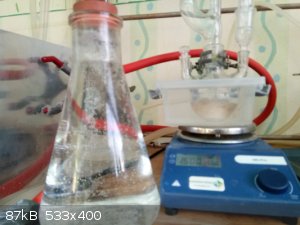
When the signs of HCl emission disappeared I put the crude product in a separatory funnel and added 60 ml of water. There is slight warming at this
step (probably caused by AcCl residue). 2 layers were formed. The ester layer was separated and washed with 30 ml of a saturated solution of NaHCO3
and then 4 times with 30ml portions of water (until the neutral reaction by pH paper).
The crude ester was put in a bottle with anhydrous MgSO4 for 2 days.
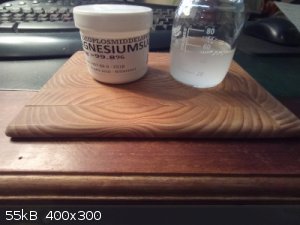 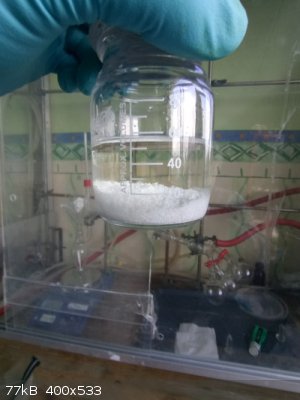
The first attempt of vacuum distillation (using magnetic stirring) was unsuccessful because of uncontrolled bumping and foaming.
The method with a capillary tube was much more successful. The capillary was made by extending (pulling) the tip of a Pasteur pipette in flame.
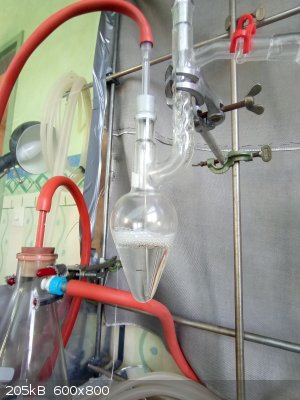
The key to success is the vacuum valve to regulate the bubbles. This type (DURAN) allows making very precise adjustments.
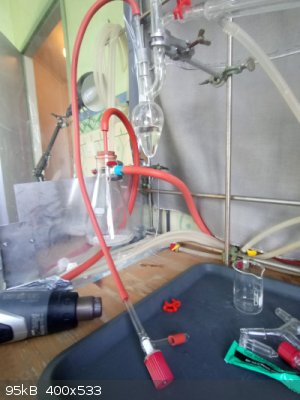
This is the system assembled.
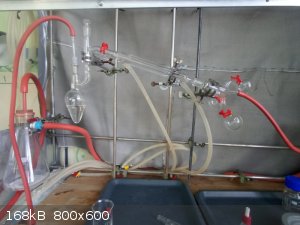
I'd like to note that the size of bubbles from the capillary tube doesn't affect the vacuum, the water aspirator has enough power to keep the pressure
independent from the stream of air through the capillary.
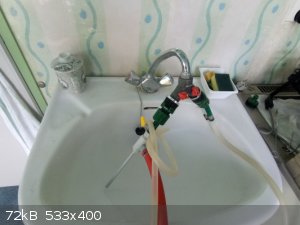
For pressure measurement, I use a simple self-made mercury manometer.
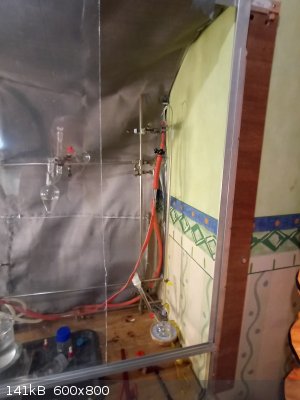 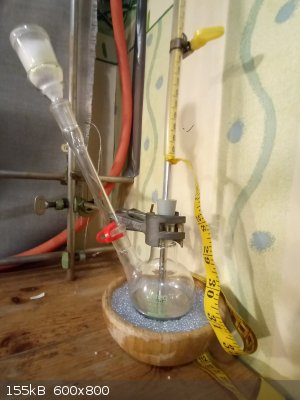
The glass tube 5/7 mm (internal/external) is bent so that it has 90mm height. The bottom part is placed inside 2-neck pear-shaped flask through a
rubber stopper. 1 kg mercury is inside the flask and the second neck has 2 layers of cotton wool with 1 layer of sulfur powder to absorb mercury
vapors. From the outside, the glass tube is protected with an FEP tube of a bigger diameter with a ruler inside. Before usage, it requires adjustment
to the current atmospheric pressure. I make it by the measurement of the temperature of the boiling water.
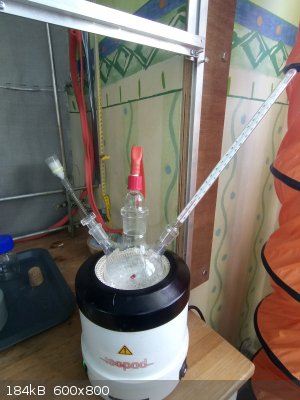
The flask is put in the heating mantle and the heat is put to a minimal level. At some point the temperature of the water (which is boiling under
vacuum) becomes constant. By the table, I adjust the outer FEP tube with the ruler to the pressure from the table (that one which causes the water to
boil at the specified temperature).
For connection to the aspirator, I use 10/20mm (internal/external) rubber hose and a safety flask (to protect the system from the outer line).
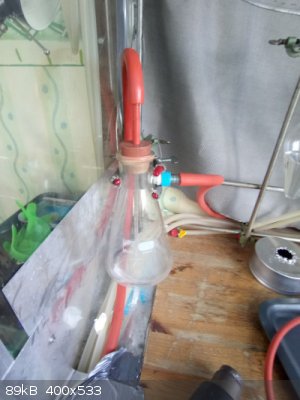
For short vacuum connections, I use 7/10mm rubber.
As a source of heat, I used a heat gun.
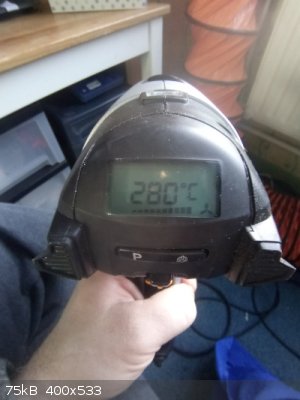 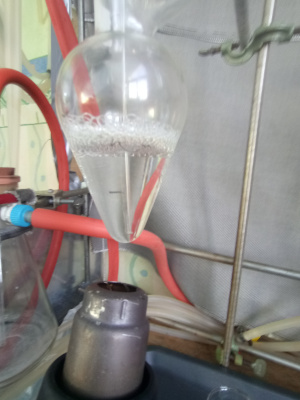
I found that to minimize bumping the flask should be heated from a side (not from the bottom as in the picture) and the air should point approx. to
the top layer of the liquid.
(I didn't take a photo during the process - my phone was discharged at this point).
Before applying the vacuum I lowered a sash to protect myself from possible glass implosion (but everything was OK).
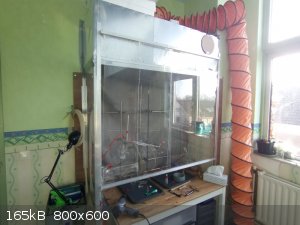
With the air at 280C it forms enough vapors and the distillation goes really very fast.
The pressure reading was 18mmHg during the whole process.
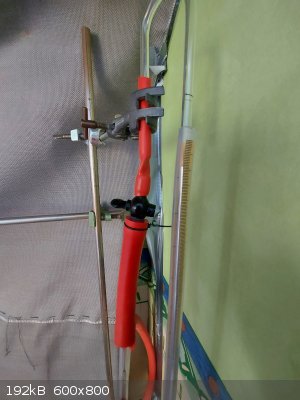
At the beginning of the distillation, the temperature of vapors raised to 105C but then it fell to 91C and stabilized. I switched the receiving flask
but as I said the speed of distillation was very high so it collected 14 ml before the switching point.
The main fraction was collected at 91-92C at 18 mmHg. It was 12 ml.
The rest was 18 ml. I forget to open the capillary tube before releasing pressure so some residue was sucked into the vacuum valve/hose.
I've put the 91-92 @ 18mmHg fraction in the storage bottle as "pure" ester and the first fraction I returned on MgSO4 and probably I will try to
purify it next time.
Now I plan to do a "saponification" test to see how much the "pure" fraction contains unreacted menthol.
As I already described, the smell of the ester is different from that of the menthol but it still has that "coldness" effect.
This is the picture of the system at the end of the distillation.
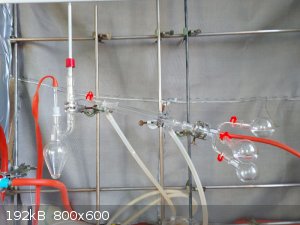
I'd like to say "thanks" to those members who encouraged me to share my report on the process. I would be glad to hear suggestions or questions. It
was only my second vacuum distillation that's why I described this step in such detail.
[Edited on 12-2-2022 by teodor]
[Edited on 12-2-2022 by teodor]
[Edited on 12-2-2022 by teodor]
|
|
|
Tsjerk
International Hazard
    
Posts: 3031
Registered: 20-4-2005
Location: Netherlands
Member Is Offline
Mood: Mood
|
|
Nice pictures! I always managed to keep foaming down with magnetic stirring, but this definitely makes me want to have such a vacuum valve.
|
|
|
teodor
National Hazard
   
Posts: 876
Registered: 28-6-2019
Location: Heerenveen
Member Is Offline
|
|
Thanks, Tsjerk.
I bought my valve second-hand at https://www.laboratorium.shop/. There is no such model there anymore, they have more expensive ones.
I am thinking to buy one or two of these next time:
https://shop.glasatelier-saillart.be/53/1/PD47/M_D_image_286...
OR
https://shop.glasatelier-saillart.be/53/1/PD47/M_D_image_286...
They are probably different in how fine adjustment could be done. For the purpose of bubble regulation, I think the coarse model should work fine but
if I will put my hand on them I will compare.
What is surprised me is that the temperature drops 14 degrees after the distillation starts and then it is constant, slowly climbing up at the end.
I observed the same effect with vacuum distillation of ethyl salicylate - it started at 110C @ 16mmHg and then fell to 102C. That time I used an oil
bath and I didn't find any dependency of the vapor temperature on the oil bath temperature, it was slowly climbing 102-104C. Is it possible that this
initial temperature drop is the effect of the fractionating arm?
[Edited on 14-2-2022 by teodor]
|
|
|